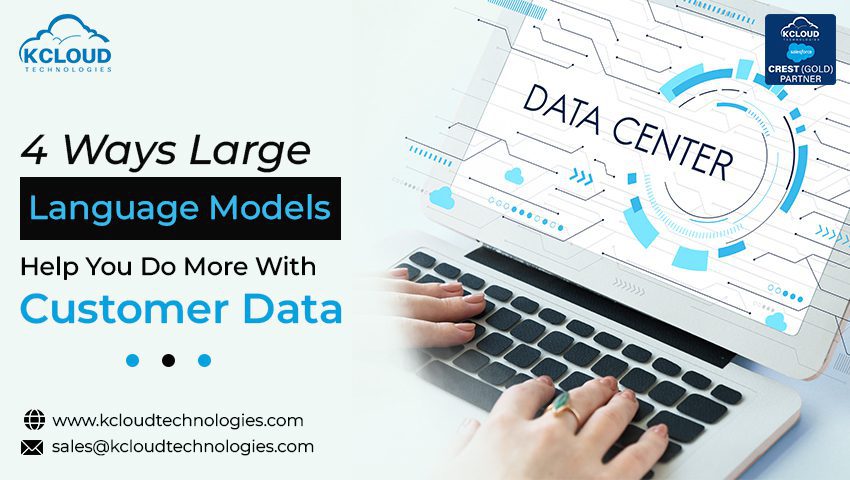In today’s data-driven business landscape, customer data is a goldmine of insights waiting to be discovered. Large language models, such as GPT-3.5, have emerged as indispensable tools for organizations seeking to extract maximum value from their customer data. Here are four ways these advanced AI models can help you harness the full potential of customer data:
1. Personalized Customer Experiences
Tailoring customer experiences is the cornerstone of successful marketing and sales strategies. Large language models can analyze vast datasets of customer information, including purchase history, preferences, and online behavior, to generate highly personalized content. From personalized email marketing campaigns to product recommendations on e-commerce websites, these models enable businesses to connect with customers on a deeply individual level, enhancing engagement and driving conversions.
2. Sentiment Analysis and Customer Feedback
Understanding customer sentiment is crucial for brand reputation management and product improvement. Large language models excel at sentiment analysis, scanning through customer reviews, social media posts, and survey responses to gauge customer opinions accurately. By identifying trends and sentiments, businesses can proactively address concerns, refine products, and cultivate a more positive brand image.
3. Predictive Analytics for Sales and Marketing
Predictive analytics powered by large language models can forecast customer behavior with remarkable precision. By analyzing historical data and current trends, these models can predict which products a customer is likely to purchase next or when they might be ready to make a buying decision. This invaluable insight enables businesses to allocate resources effectively, optimize marketing campaigns, and prioritize sales efforts for maximum ROI.
4. Automating Data-Intensive Tasks
Large language models can automate time-consuming data entry and analysis tasks, reducing human error and freeing up valuable resources. They can help streamline data collection, data cleansing, and data visualization processes, allowing teams to focus on more strategic tasks. Whether it’s automatically categorizing customer inquiries or generating reports, these models enhance efficiency across the organization.
Enhancing Search Efficiency in Large Data Sets with LLMS
In today’s data-driven world, organizations are constantly inundated with vast amounts of information. Whether it’s customer data, financial records, or research findings, managing and extracting valuable insights from large data sets can be a daunting task. However, with the advent of Language Model Management Systems (LLMS), a new era of efficient data search and retrieval has emerged.
The Challenge of Large Data Sets
Large data sets have become commonplace in various industries, including finance, healthcare, e-commerce, and scientific research. While these data sets hold immense potential for uncovering valuable patterns and insights, their sheer volume can overwhelm traditional search methods. Manually sifting through thousands or even millions of records to find relevant information is time-consuming, error-prone, and often impractical.
Enter LLMS
LLMS are sophisticated language models that have been designed to understand and generate human-like text. These models excel at natural language processing tasks, making them incredibly powerful tools for searching and retrieving information within large data sets. Here’s how LLMS enables a more efficient search:
1. Natural Language Understanding:
LLMS can interpret and understand natural language queries. This means that users can express their search criteria in plain language, eliminating the need for complex query languages or search syntax. For example, instead of writing a convoluted SQL query, a user can simply ask, “Find all customer complaints from the past month.” LLMS will interpret this query and retrieve the relevant data.
2. Contextual Understanding:
LLMS don’t just match keywords; they grasp the context of a query. They understand synonyms, homonyms, and even context-specific language. This contextual understanding ensures that search results are more accurate and relevant. If a user searches for “apple,” LLMS can determine if they mean the fruit or the technology company based on the context of the query.
3. Multimodal Data Processing:
LLMS can process various types of data, including text, images, and even structured data. This versatility enables organizations to search and retrieve information from diverse data sources. For instance, LLMS can analyze both the text descriptions and images associated with products in an e-commerce database to provide comprehensive search results.
4. Adaptive Learning:
LLMS can adapt and improve over time. As users interact with the system and provide feedback, the model can refine its understanding and improve the accuracy of search results. This adaptive learning ensures that LLMS becomes more effective at helping users find the information they need as time goes on.
Real-World Applications
The applications of LLMS inefficient data search are vast. Organizations can use LLMS to:
- Streamline customer support by quickly retrieving relevant information from a vast knowledge base.
- Enhance data-driven decision-making by rapidly extracting insights from large datasets.
- Improve research efficiency by automating the search for relevant academic papers and documents.
- Optimize e-commerce product search, leading to better user experiences and increased sales.
In conclusion, large language models like GPT-3.5 offer a transformative approach to managing and leveraging customer data. By personalizing customer experiences, analyzing sentiment, enabling predictive analytics, and automating data-intensive tasks, businesses can gain a competitive edge, foster customer loyalty, and unlock new opportunities for growth in the data-driven era. Embracing the power of AI-driven insights is not just a trend but a strategic imperative for businesses looking to thrive in a rapidly evolving marketplace.

